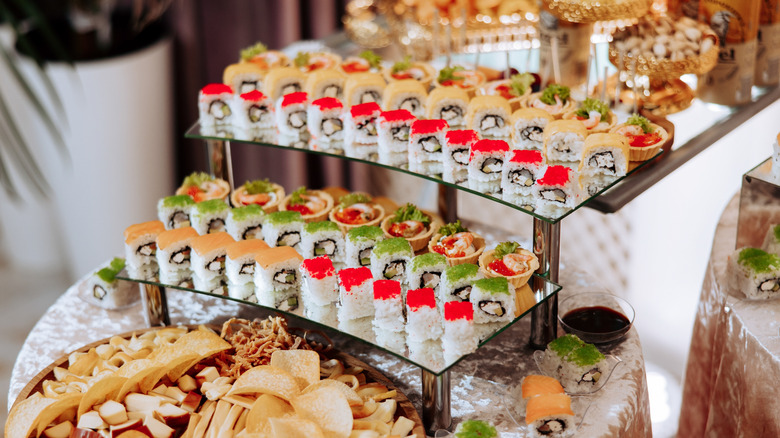Why Sushi Is A Risk At Buffet Tables
Wherever you travel, you're sure to happen upon an all-you-can-eat buffet. Seemingly endless trays of beautifully presented food tempt you to indulge as voraciously as the Ancient Romans did. Across the U.S., you'll find the absolute best buffets that offer a wide display of hot and cold favorites to choose from, including sushi as one of the more popular items. Unfortunately, not all buffets take the optimal care required for preparing and serving sushi on a large scale, so you could be at risk by eating sushi that may not be as fresh as what you'd enjoy at a sushi restaurant.
When not properly chilled — and kept chilled for two hours — sushi becomes a breeding ground for norovirus and salmonella bacteria, the top two pathogens that the CDC attributes to foodborne illnesses that sicken 48 million people annually. But even if the buffet staff is diligent in keeping sushi chilled at below 40 degrees Fahrenheit (the temperature when bacteria begins to grow), you're still exposed to germs from all the other people — whose hygiene may not be as meticulous as yours — helping themselves to the California roll. Even touching the serving utensils or the sneeze guard can pass foodborne illness from one person to another. And if you don't see a sneeze guard above the sushi, it's a red flag at a buffet that signals you should hightail out of there.
The buffet may not have prepared the sushi properly
Although there's a difference between sushi and sashimi, food safety precautions require that for both preparations the fish must be sushi grade, and per FDA guidelines, previously frozen to -4 degrees Fahrenheit (-20 degrees Celsius) or below for seven days or -31 degrees Fahrenheit (-35 degrees Celsius) or below for 15 hours. This deep freeze kills pathogens and parasitic worms, which you might encounter in packaged fish. Recently, a well-known TikTok food critic was reviewing a popular sushi buffet restaurant in Seattle when viewers allegedly noticed a worm wriggling out of the sashimi he was about to pop into his mouth. The sushi bar subsequently shut its doors at both locations until a full investigation was conducted.
If a highly regarded restaurant possibly served improperly prepared fish, there's a chance that the sushi at a cheap buffet that's geared for mass consumption has not been prepared by the FDA's guidelines. Albacore, yellowfin, and other types of tuna don't need to be frozen, but unless you see a dedicated chef making sushi to order, you probably won't know when it was prepared and for how long it's been sitting out on the buffet table. Lastly, the FDA warns that pregnant women, children, elderly adults, and people with compromised immune systems are most susceptible to serious (and even fatal) foodborne illness and should avoid raw fish altogether. Taking all these risks into consideration, it might be best to skip the sushi at a buffet table.

